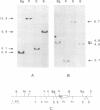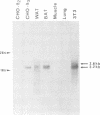Abstract
The gene encoding the murine beta 3-adrenergic receptor (beta 3AR) has been isolated. It translates into a polypeptide of 388 amino acid residues which shows 82% overall homology with the human beta 3AR. In Southern blot experiments, a probe derived from the murine beta 3AR gene hybridizes to a unique restriction fragment in the murine and human genomes. In both species, the beta 3AR gene is located on chromosome 8, in regions (8A2----8A4 in mouse, and 8p11----8p12 in man) which are conserved between mouse and man. The pharmacological profile of the mouse beta 3AR strongly resembles that of the human beta 3AR. It is characterized by a low affinity toward the radiolabelled beta-adrenergic antagonist [125I]Iodocyanopindolol and a low efficiency of other antagonists such as propranolol, ICI 118551 or CGP 20712A to inhibit cAMP production induced by isoproterenol. Another salient feature shared by the murine and the human beta 3ARs is the very potent effect of the lipolytic compound BRL 37344 on cAMP accumulation and the partial agonistic effect of the beta 1- and beta 2-adrenergic antagonists CGP 12177A, oxprenolol and pindolol. These properties are very close to those ascribed to the atypical beta AR of rodent adipocytes. In addition, Northern blot analyses indicate that the beta 3AR gene is mainly expressed in mouse brown and white adipose tissues, suggesting that the murine beta 3AR described here is the atypical beta AR involved in the control of energy expenditure in fat tissue.
Full text
PDF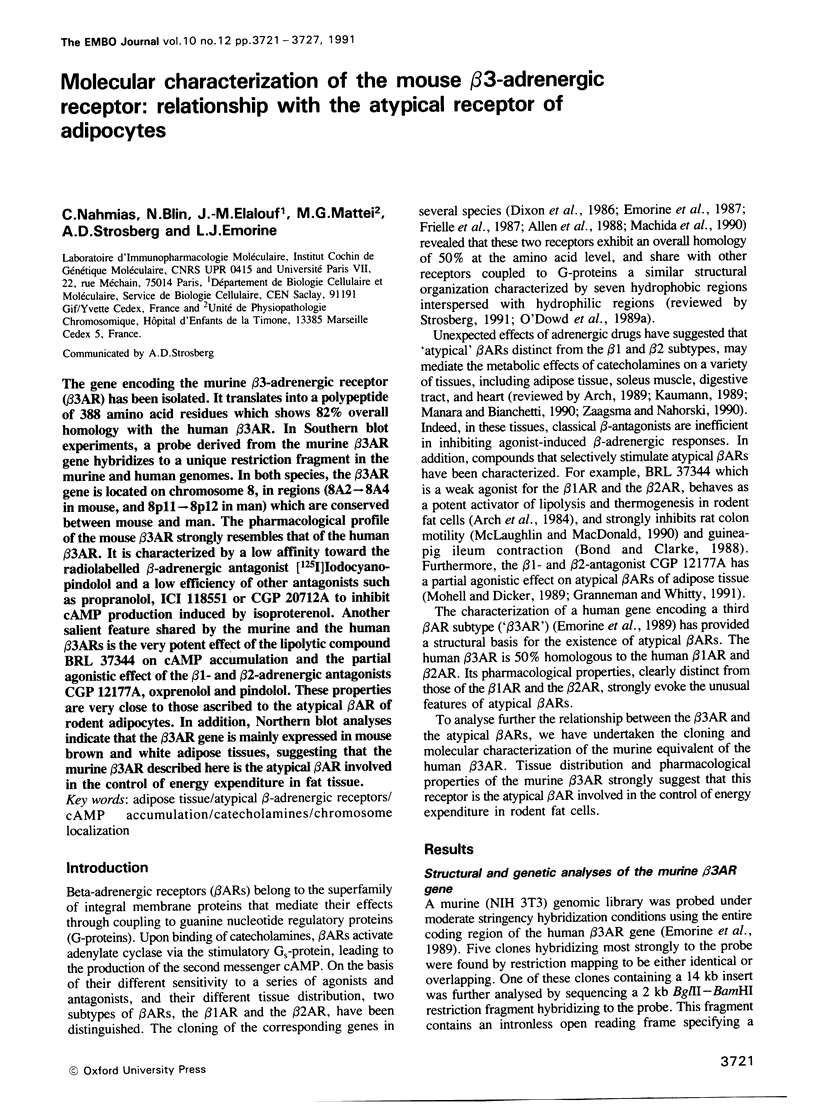
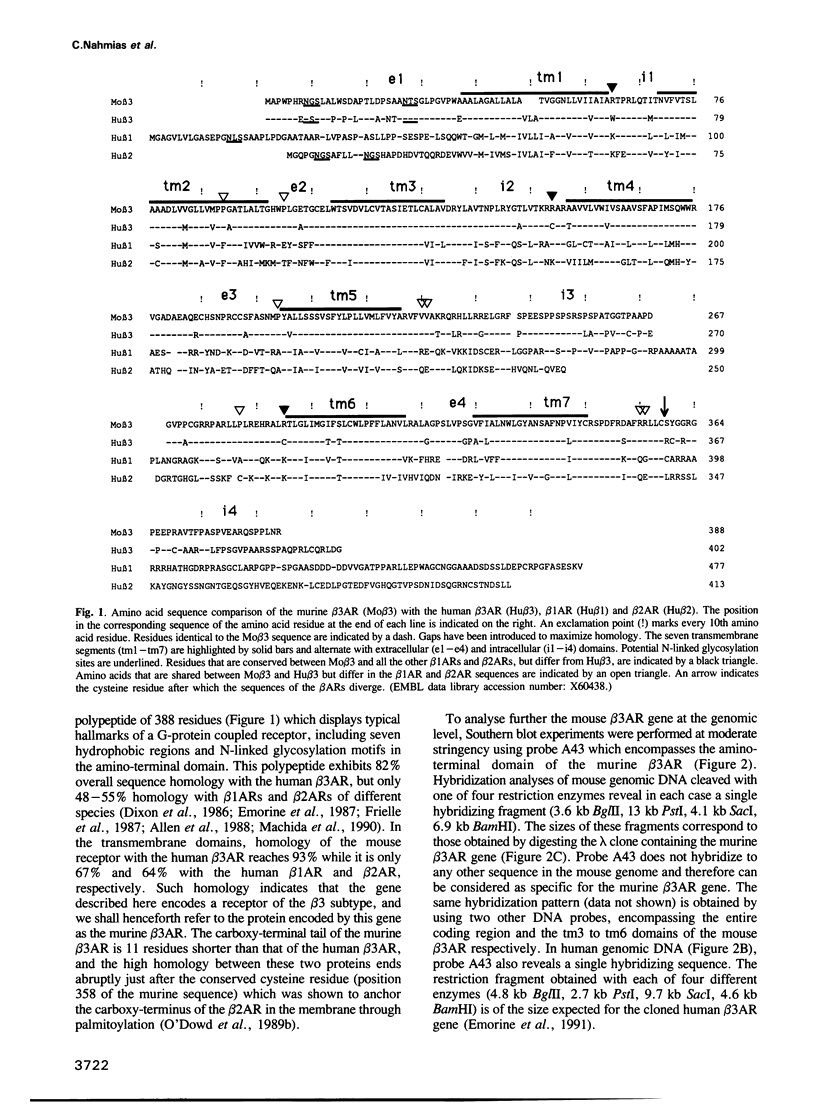
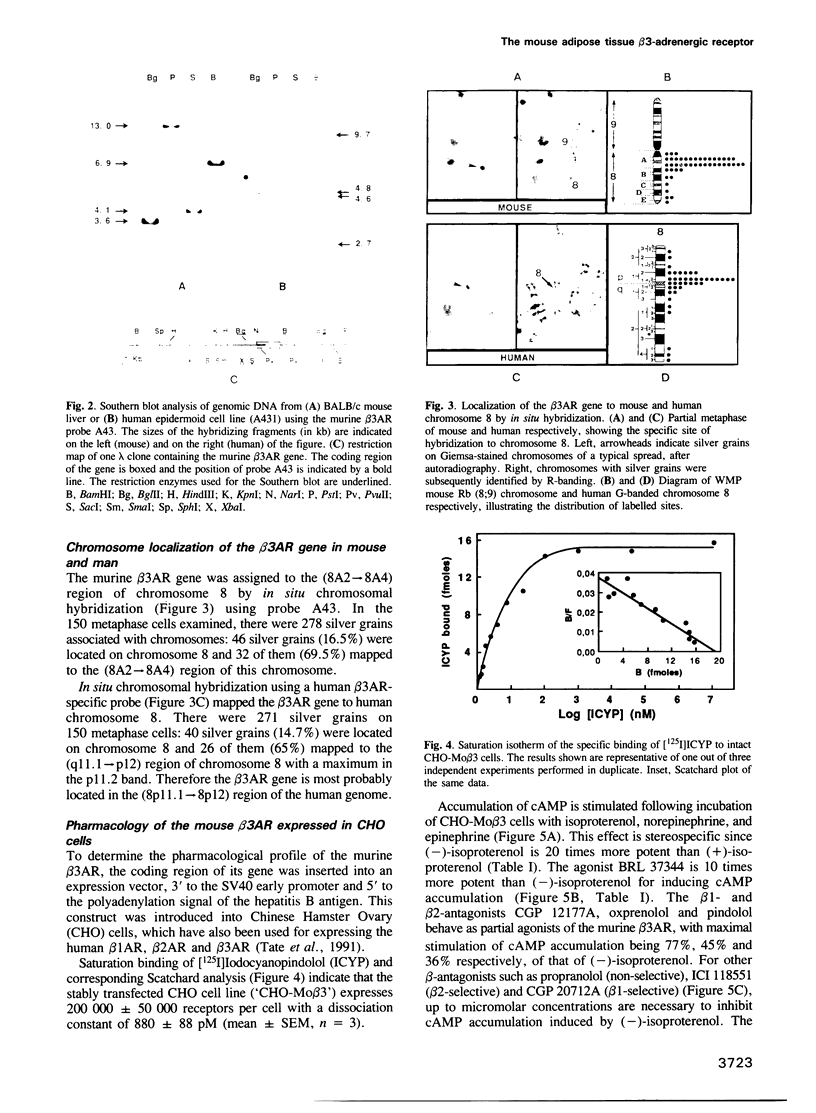
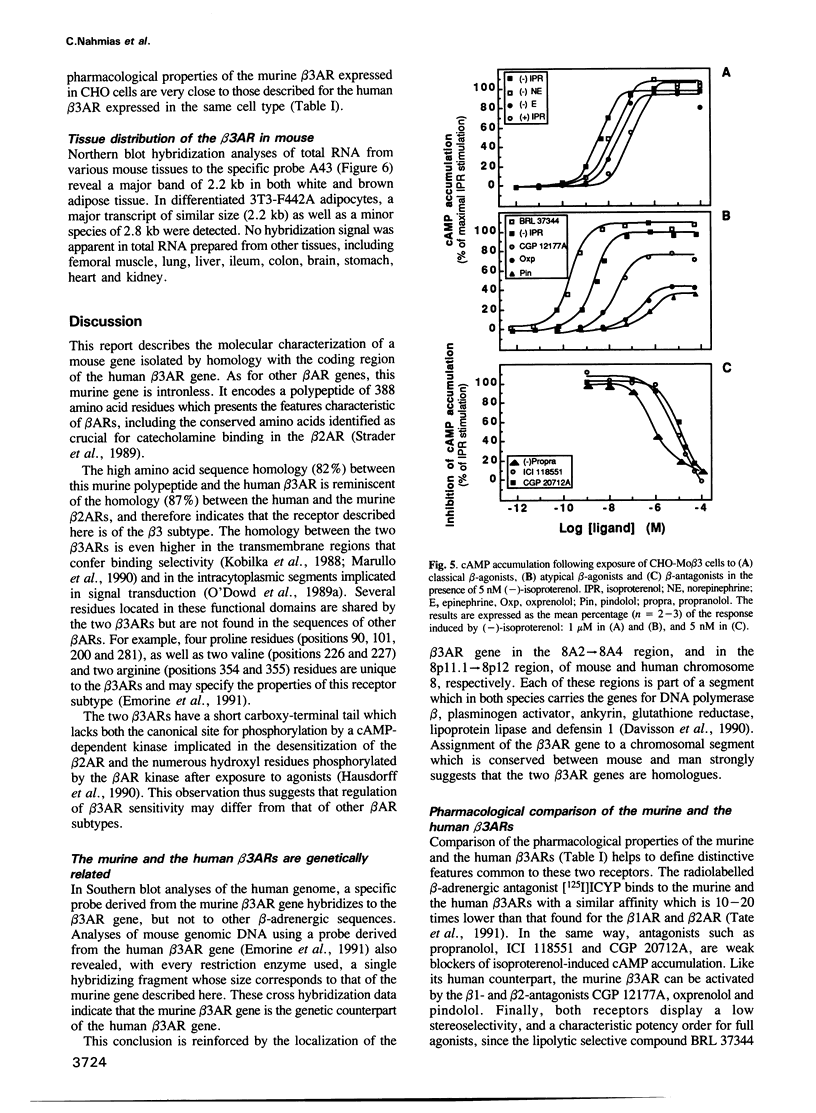
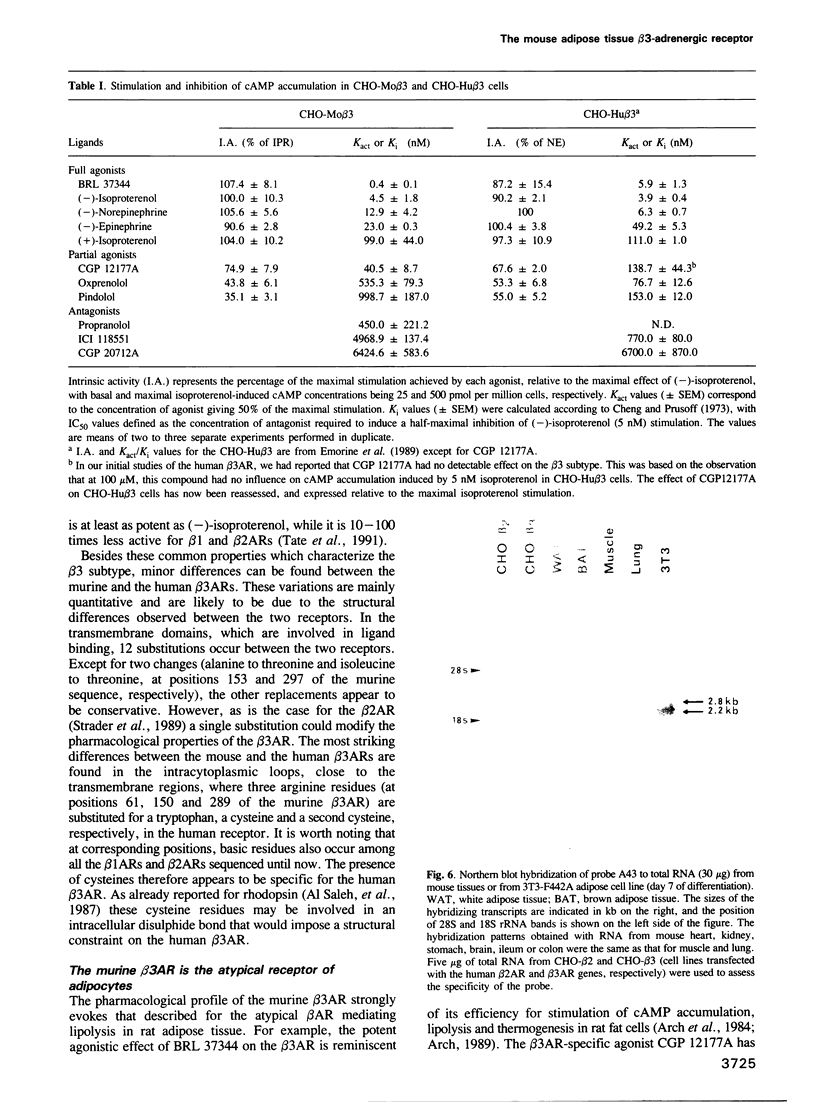
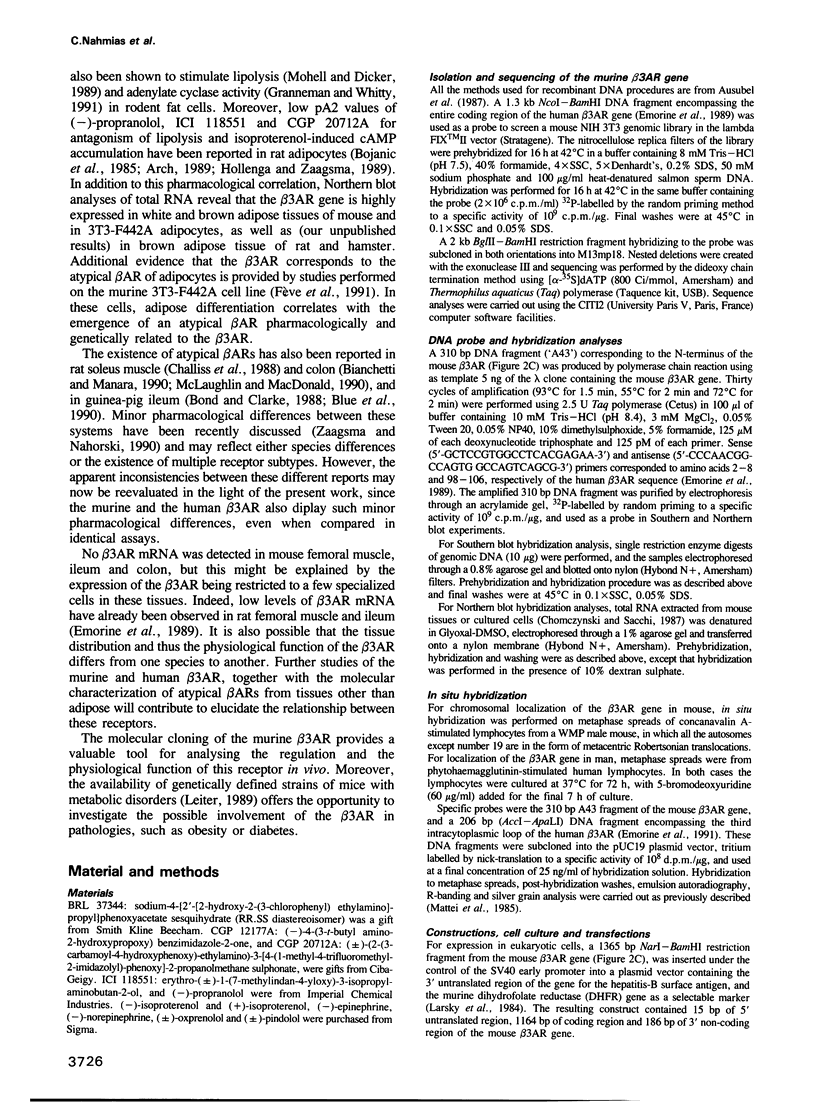
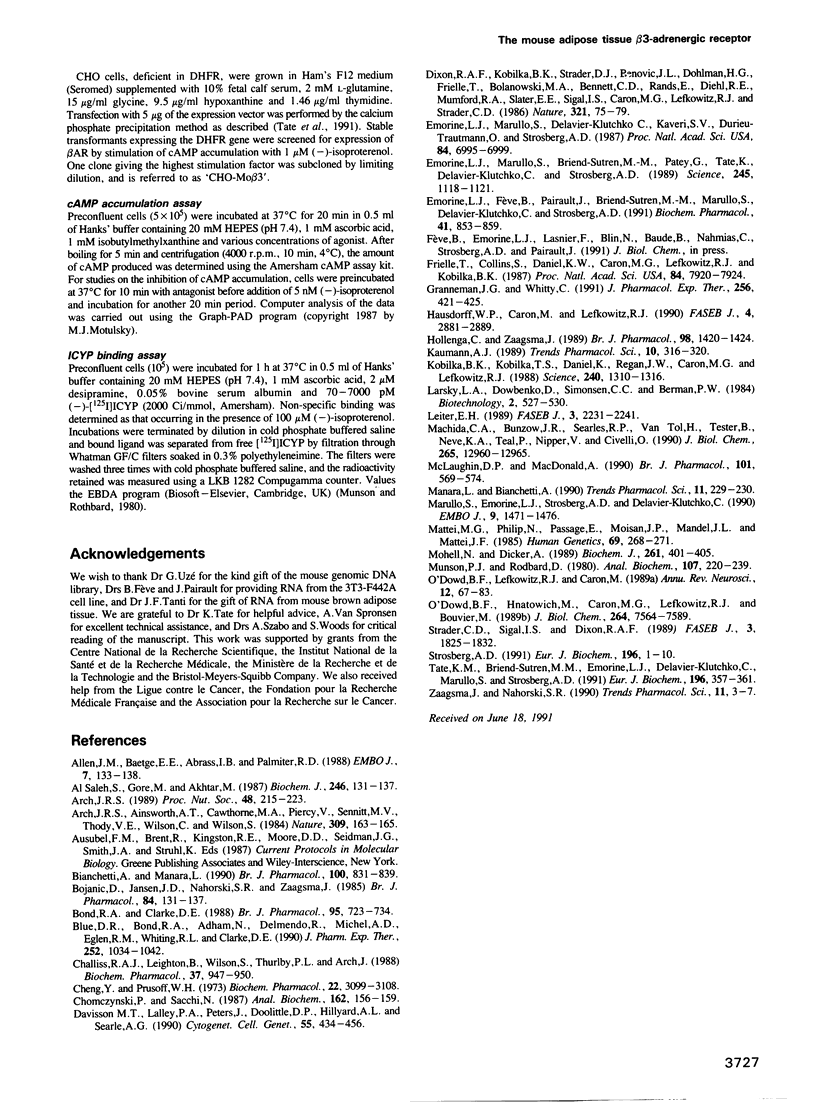
Images in this article
Selected References
These references are in PubMed. This may not be the complete list of references from this article.
- Al-Saleh S., Gore M., Akhtar M. On the disulphide bonds of rhodopsins. Biochem J. 1987 Aug 15;246(1):131–137. doi: 10.1042/bj2460131. [DOI] [PMC free article] [PubMed] [Google Scholar]
- Allen J. M., Baetge E. E., Abrass I. B., Palmiter R. D. Isoproterenol response following transfection of the mouse beta 2-adrenergic receptor gene into Y1 cells. EMBO J. 1988 Jan;7(1):133–138. doi: 10.1002/j.1460-2075.1988.tb02792.x. [DOI] [PMC free article] [PubMed] [Google Scholar]
- Arch J. R., Ainsworth A. T., Cawthorne M. A., Piercy V., Sennitt M. V., Thody V. E., Wilson C., Wilson S. Atypical beta-adrenoceptor on brown adipocytes as target for anti-obesity drugs. Nature. 1984 May 10;309(5964):163–165. doi: 10.1038/309163a0. [DOI] [PubMed] [Google Scholar]
- Arch J. R. The brown adipocyte beta-adrenoceptor. Proc Nutr Soc. 1989 Jul;48(2):215–223. doi: 10.1079/pns19890032. [DOI] [PubMed] [Google Scholar]
- Berman T., Paisey T. Personality in assaultive and non-assaultive juvenile male offenders. Psychol Rep. 1984 Apr;54(2):527–530. doi: 10.2466/pr0.1984.54.2.527. [DOI] [PubMed] [Google Scholar]
- Bianchetti A., Manara L. In vitro inhibition of intestinal motility by phenylethanolaminotetralines: evidence of atypical beta-adrenoceptors in rat colon. Br J Pharmacol. 1990 Aug;100(4):831–839. doi: 10.1111/j.1476-5381.1990.tb14100.x. [DOI] [PMC free article] [PubMed] [Google Scholar]
- Blue D. R., Bond R. A., Adham N., Delmendo R., Michel A. D., Eglen R. M., Whiting R. L., Clarke D. E. Antagonist characterization of atypical beta adrenoceptors in guinea pig ileum: blockade by alprenolol and dihydroalprenolol. J Pharmacol Exp Ther. 1990 Mar;252(3):1034–1042. [PubMed] [Google Scholar]
- Bojanic D., Jansen J. D., Nahorski S. R., Zaagsma J. Atypical characteristics of the beta-adrenoceptor mediating cyclic AMP generation and lipolysis in the rat adipocyte. Br J Pharmacol. 1985 Jan;84(1):131–137. [PMC free article] [PubMed] [Google Scholar]
- Bond R. A., Clarke D. E. Agonist and antagonist characterization of a putative adrenoceptor with distinct pharmacological properties from the alpha- and beta-subtypes. Br J Pharmacol. 1988 Nov;95(3):723–734. doi: 10.1111/j.1476-5381.1988.tb11698.x. [DOI] [PMC free article] [PubMed] [Google Scholar]
- Challiss R. A., Leighton B., Wilson S., Thurlby P. L., Arch J. R. An investigation of the beta-adrenoceptor that mediates metabolic responses to the novel agonist BRL28410 in rat soleus muscle. Biochem Pharmacol. 1988 Mar 1;37(5):947–950. doi: 10.1016/0006-2952(88)90186-4. [DOI] [PubMed] [Google Scholar]
- Cheng Y., Prusoff W. H. Relationship between the inhibition constant (K1) and the concentration of inhibitor which causes 50 per cent inhibition (I50) of an enzymatic reaction. Biochem Pharmacol. 1973 Dec 1;22(23):3099–3108. doi: 10.1016/0006-2952(73)90196-2. [DOI] [PubMed] [Google Scholar]
- Chomczynski P., Sacchi N. Single-step method of RNA isolation by acid guanidinium thiocyanate-phenol-chloroform extraction. Anal Biochem. 1987 Apr;162(1):156–159. doi: 10.1006/abio.1987.9999. [DOI] [PubMed] [Google Scholar]
- Davisson M. T., Lalley P. A., Peters J., Doolittle D. P., Hillyard A. L., Searle A. G. Report of the comparative subcommittee for human and mouse homologies. Cytogenet Cell Genet. 1990;55(1-4):434–456. doi: 10.1159/000133026. [DOI] [PubMed] [Google Scholar]
- Dixon R. A., Kobilka B. K., Strader D. J., Benovic J. L., Dohlman H. G., Frielle T., Bolanowski M. A., Bennett C. D., Rands E., Diehl R. E. Cloning of the gene and cDNA for mammalian beta-adrenergic receptor and homology with rhodopsin. Nature. 1986 May 1;321(6065):75–79. doi: 10.1038/321075a0. [DOI] [PubMed] [Google Scholar]
- Emorine L. J., Feve B., Pairault J., Briend-Sutren M. M., Marullo S., Delavier-Klutchko C., Strosberg D. A. Structural basis for functional diversity of beta 1-, beta 2- and beta 3-adrenergic receptors. 1991 Mar 15-Apr 1Biochem Pharmacol. 41(6-7):853–859. doi: 10.1016/0006-2952(91)90188-b. [DOI] [PubMed] [Google Scholar]
- Emorine L. J., Marullo S., Briend-Sutren M. M., Patey G., Tate K., Delavier-Klutchko C., Strosberg A. D. Molecular characterization of the human beta 3-adrenergic receptor. Science. 1989 Sep 8;245(4922):1118–1121. doi: 10.1126/science.2570461. [DOI] [PubMed] [Google Scholar]
- Emorine L. J., Marullo S., Delavier-Klutchko C., Kaveri S. V., Durieu-Trautmann O., Strosberg A. D. Structure of the gene for human beta 2-adrenergic receptor: expression and promoter characterization. Proc Natl Acad Sci U S A. 1987 Oct;84(20):6995–6999. doi: 10.1073/pnas.84.20.6995. [DOI] [PMC free article] [PubMed] [Google Scholar]
- Frielle T., Collins S., Daniel K. W., Caron M. G., Lefkowitz R. J., Kobilka B. K. Cloning of the cDNA for the human beta 1-adrenergic receptor. Proc Natl Acad Sci U S A. 1987 Nov;84(22):7920–7924. doi: 10.1073/pnas.84.22.7920. [DOI] [PMC free article] [PubMed] [Google Scholar]
- Granneman J. G., Whitty C. J. CGP 12177A modulates brown fat adenylate cyclase activity by interacting with two distinct receptor sites. J Pharmacol Exp Ther. 1991 Feb;256(2):421–425. [PubMed] [Google Scholar]
- Hausdorff W. P., Caron M. G., Lefkowitz R. J. Turning off the signal: desensitization of beta-adrenergic receptor function. FASEB J. 1990 Aug;4(11):2881–2889. [PubMed] [Google Scholar]
- Hollenga C., Zaagsma J. Direct evidence for the atypical nature of functional beta-adrenoceptors in rat adipocytes. Br J Pharmacol. 1989 Dec;98(4):1420–1424. doi: 10.1111/j.1476-5381.1989.tb12692.x. [DOI] [PMC free article] [PubMed] [Google Scholar]
- Kaumann A. J. Is there a third heart beta-adrenoceptor? Trends Pharmacol Sci. 1989 Aug;10(8):316–320. doi: 10.1016/0165-6147(89)90065-5. [DOI] [PubMed] [Google Scholar]
- Kobilka B. K., Kobilka T. S., Daniel K., Regan J. W., Caron M. G., Lefkowitz R. J. Chimeric alpha 2-,beta 2-adrenergic receptors: delineation of domains involved in effector coupling and ligand binding specificity. Science. 1988 Jun 3;240(4857):1310–1316. doi: 10.1126/science.2836950. [DOI] [PubMed] [Google Scholar]
- Leiter E. H. The genetics of diabetes susceptibility in mice. FASEB J. 1989 Sep;3(11):2231–2241. doi: 10.1096/fasebj.3.11.2673897. [DOI] [PubMed] [Google Scholar]
- Machida C. A., Bunzow J. R., Searles R. P., Van Tol H., Tester B., Neve K. A., Teal P., Nipper V., Civelli O. Molecular cloning and expression of the rat beta 1-adrenergic receptor gene. J Biol Chem. 1990 Aug 5;265(22):12960–12965. [PubMed] [Google Scholar]
- Manara L., Bianchetti A. Further heterogeneity of the beta-adrenoceptor. The phenylethanolaminotetralines: new selective agonists for atypical beta-adrenoceptors. Trends Pharmacol Sci. 1990 Jun;11(6):229–230. doi: 10.1016/0165-6147(90)90247-6. [DOI] [PubMed] [Google Scholar]
- Marullo S., Emorine L. J., Strosberg A. D., Delavier-Klutchko C. Selective binding of ligands to beta 1, beta 2 or chimeric beta 1/beta 2-adrenergic receptors involves multiple subsites. EMBO J. 1990 May;9(5):1471–1476. doi: 10.1002/j.1460-2075.1990.tb08264.x. [DOI] [PMC free article] [PubMed] [Google Scholar]
- Mattei M. G., Philip N., Passage E., Moisan J. P., Mandel J. L., Mattei J. F. DNA probe localization at 18p113 band by in situ hybridization and identification of a small supernumerary chromosome. Hum Genet. 1985;69(3):268–271. doi: 10.1007/BF00293038. [DOI] [PubMed] [Google Scholar]
- McLaughlin D. P., MacDonald A. Evidence for the existence of 'atypical' beta-adrenoceptors (beta 3-adrenoceptors) mediating relaxation in the rat distal colon in vitro. Br J Pharmacol. 1990 Nov;101(3):569–574. doi: 10.1111/j.1476-5381.1990.tb14122.x. [DOI] [PMC free article] [PubMed] [Google Scholar]
- Mohell N., Dicker A. The beta-adrenergic radioligand [3H]CGP-12177, generally classified as an antagonist, is a thermogenic agonist in brown adipose tissue. Biochem J. 1989 Jul 15;261(2):401–405. doi: 10.1042/bj2610401. [DOI] [PMC free article] [PubMed] [Google Scholar]
- Munson P. J., Rodbard D. Ligand: a versatile computerized approach for characterization of ligand-binding systems. Anal Biochem. 1980 Sep 1;107(1):220–239. doi: 10.1016/0003-2697(80)90515-1. [DOI] [PubMed] [Google Scholar]
- O'Dowd B. F., Hnatowich M., Caron M. G., Lefkowitz R. J., Bouvier M. Palmitoylation of the human beta 2-adrenergic receptor. Mutation of Cys341 in the carboxyl tail leads to an uncoupled nonpalmitoylated form of the receptor. J Biol Chem. 1989 May 5;264(13):7564–7569. [PubMed] [Google Scholar]
- O'Dowd B. F., Lefkowitz R. J., Caron M. G. Structure of the adrenergic and related receptors. Annu Rev Neurosci. 1989;12:67–83. doi: 10.1146/annurev.ne.12.030189.000435. [DOI] [PubMed] [Google Scholar]
- Strader C. D., Sigal I. S., Dixon R. A. Structural basis of beta-adrenergic receptor function. FASEB J. 1989 May;3(7):1825–1832. doi: 10.1096/fasebj.3.7.2541037. [DOI] [PubMed] [Google Scholar]
- Strosberg A. D. Structure/function relationship of proteins belonging to the family of receptors coupled to GTP-binding proteins. Eur J Biochem. 1991 Feb 26;196(1):1–10. doi: 10.1111/j.1432-1033.1991.tb15778.x. [DOI] [PubMed] [Google Scholar]
- Tate K. M., Briend-Sutren M. M., Emorine L. J., Delavier-Klutchko C., Marullo S., Strosberg A. D. Expression of three human beta-adrenergic-receptor subtypes in transfected Chinese hamster ovary cells. Eur J Biochem. 1991 Mar 14;196(2):357–361. doi: 10.1111/j.1432-1033.1991.tb15824.x. [DOI] [PubMed] [Google Scholar]
- Zaagsma J., Nahorski S. R. Is the adipocyte beta-adrenoceptor a prototype for the recently cloned atypical 'beta 3-adrenoceptor'? Trends Pharmacol Sci. 1990 Jan;11(1):3–7. doi: 10.1016/0165-6147(90)90032-4. [DOI] [PubMed] [Google Scholar]




